Learning Together: Tapping into the Unique Resilience of a Remote Island Community
December 18, 2023
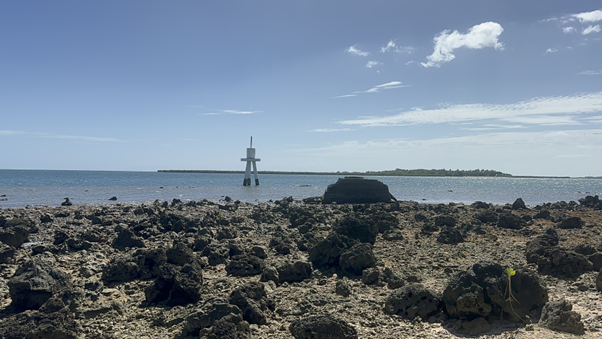
Pacific Island Countries are at the forefront of climate change impacts despite being responsible for less than 0.03 percent of global greenhouse gas (GHG) emissions. More frequent and severe tropical cyclones, rising sea levels, loss of land, and climate-induced relocation are just some of the major concerns people of the Pacific are facing. For remote island communities away from the mainland, climate change impacts are felt at an even greater level.
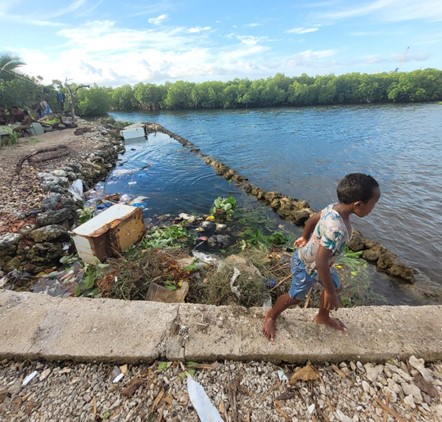
Rising sea-levels are a major concern for Pacific coastal communities such as Vio Island in Fiji.
As part of our collective intelligence research work, the Accelerator Lab team had the honour of being welcomed into the community of Vio Island, a small island off the western part of Fiji’s largest island Viti Levu. Vio Island was the first community where the UNDP Fiji Rural Electrification Fund (FREF) Project was piloted. In Fiji, 96 percent of the population has access to energy, with the FREF project aiming to bring access to the last 4 percent through renewable energy sources such as solar power. This is an ambitious and crucial feat as many of these communities are in some of the most remote parts of Fiji with limited accessibility.
It was with the island community of Vio that the AccLab team applied collective intelligence methodologies such as storytelling (or Talanoa in Fiji), deliberation, and citizen-generated data to explore and understand how communities were impacted and adapting to climate change impacts, and how access to solar energy could act as an enabler for increased community resilience and improve their economic opportunities and livelihoods. By giving community members the space to share their stories we also hoped to empower them to determine the future direction of development in their community, by highlighting their current major challenges and needs, as well as their future aspirations.
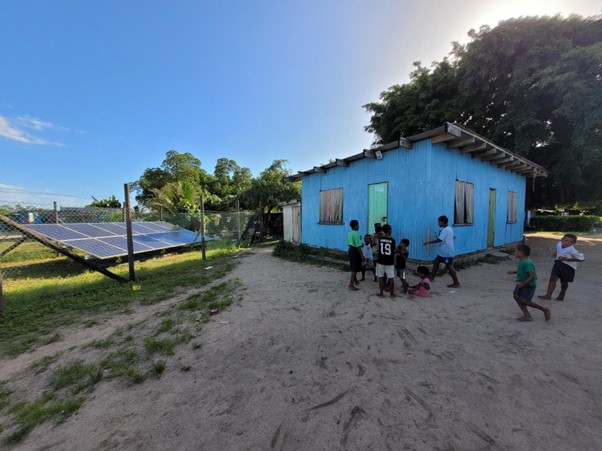
UNDP Fiji Rural Electrification Fund (FREF) Project was piloted.
What do we learn from community members’ on the most pressing climate change impacts?
Community members shared their collective concern on how climate change impacts were severely affecting their community. During Tropical Cyclones Winston (2016) and Harold (2020), the entire island had been flooded, damaging many of their homes. Rising sea levels is a major concern as well, as this also sees a loss of land and the flow on effect of running out of space to build new homes.
They have also noticed a change in fish stocks. One community member — a free diver whose main source of income is derived from the fish and octopus she catches during the day and sells at the Lautoka wharf market on the main island — explained how catching octopus is not as easy as it used to be in previous years. She now needs to swim further out from her usual fishing spots and stay in the water much longer to be able to get a catch. Community members also shared concerns about nearby coral harvesting, which they believe could be further affecting the health of their reef and marine life. They have noticed an increasing amount of dead, broken coral being washed up on their shores for some years now.

The uninhabited side of Vio Island where community members collect rocks for building their seawalls.
How are community members adapting to climate change impacts?
Vio Island is a true example of what it means to be at the forefront of climate change impacts. To address some of these impacts, community members have come up with their own adaptive measures, including:
- Self-built seawalls
Some community members have taken the initiative to build seawalls to protect the area sounding their homes. Three different types of seawalls were observed to have been constructed by the community. The first was made of large rocks, which had been collected from the opposite side of the Vio Island and the neighboring island, stacks on top of each other and secured with cement. The second type was also constructed with large rocks, but these were secured with metal wiring. The third type was built using old refrigerators, lined in a row, and filled with heavy rocks to weigh them down and keep them in place.
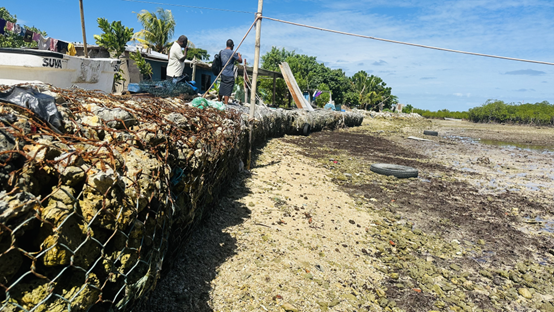
Community self-built seawall using rocks and wiring.
- Land reclamation
The island community of Vio is seeing firsthand the implications of climate-change induced sea level rise and resulting loss of land. We learnt that the community has devised a way to use one of their challenges to solve another. Being away from the main island, Vio does not receive waste collection services. Where much of this waste began to pile up in makeshift/open dumpsites around the island, some community members began to collect these discarded materials and compress them (mostly plastic packaging) together with broken coral and rocks- which are collected by children from the seabed, to raise and extend their land area, where they intend to build more homes for their growing community in the future.
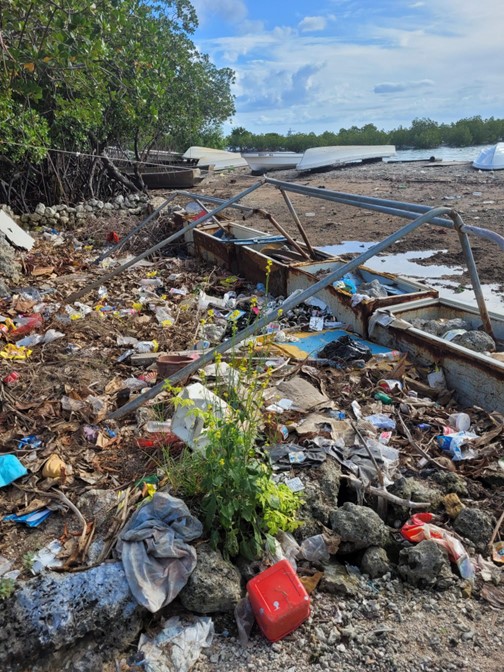
Old fridges used as makeshift seawall with compacted waste used to build up/ reclaim land.
- Entombing food for storage and preservation
Community members also shared how entombing food is one way they have learnt to store and preserve food during climate induced disasters, such as cyclones, to increase their food security and resilience. A community member explained how they learnt entombing their root crops such as dalo, yams, cassavas, bananas deep in the sand under their homes, and covering them with damp potato sacks, would help such food resources last longer, so that they would still have ample food to eat during and after the disasters have passed.
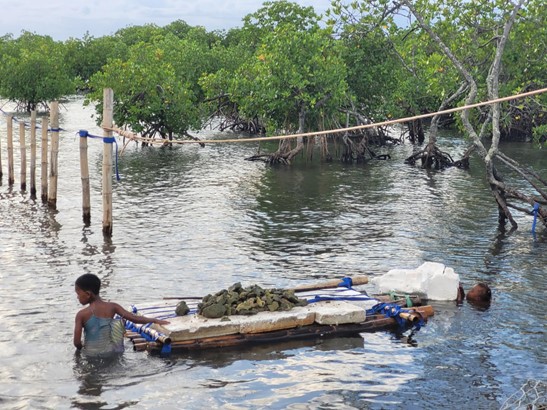
Children collect rocks from the seabed to help their families build seawalls.
As one can imagine many insights were uncovered on the daily and long-term challenges faced by the Vio island community due to climate change impacts, as well as a range of innovative ways they have learnt to adapt to these challenges – proving the resilience and self-reliance of remote communities.
Despite the community's pro-activeness in finding adaptive measures - whether short term, long term - we must still ask how can development organizations and governments ensure development activities reach communities that need it the most? And that proposed activities take into account communities lived realities and truly meet their unique needs? Yet, in the context of large ocean developing states such as Fiji, we will continue to observe community crafted adaptive measures which are frugal unless there are innovative financial instruments available to convert these solutions into sustainable ones.
In the next blog we deep-dive and learn from Vio communities into the ways access to energy can act as an enabler for increasing resilience towards climate change impacts, boost economic activities and livelihoods, including how collective intelligence can inform, empower, and shape community development.
Acknowledgements:
Patrick Tuimalealiifano, Vineil Narayan and Vatimosi Delailovu of the UNDP Pacific Office in Fiji.
Gina Lucarelli, Bas Leurs, Alexandru Oprunenco and the Nesta team for their guidance and input.
Special acknowledgement to the participants of Vio Island Community for sharing their invaluable time, expertise, and insights.

 Locations
Locations

